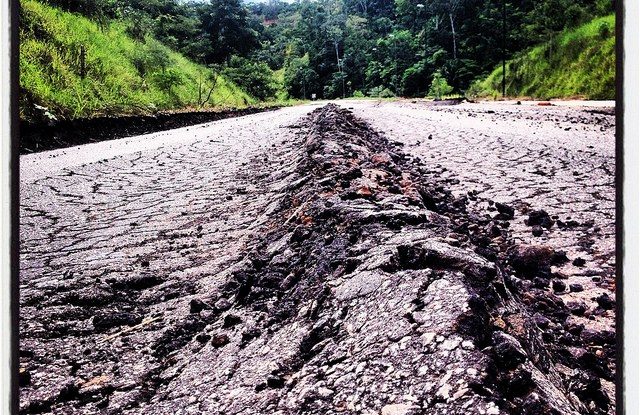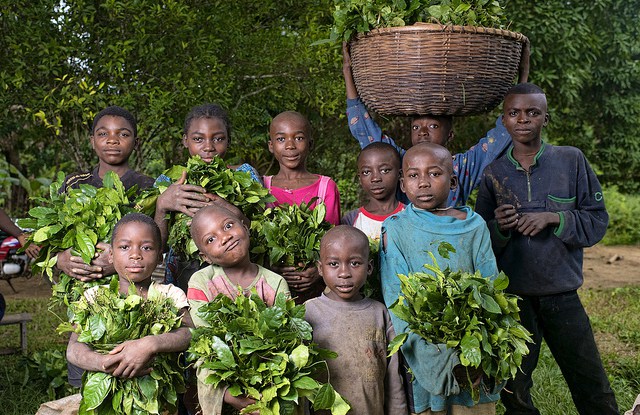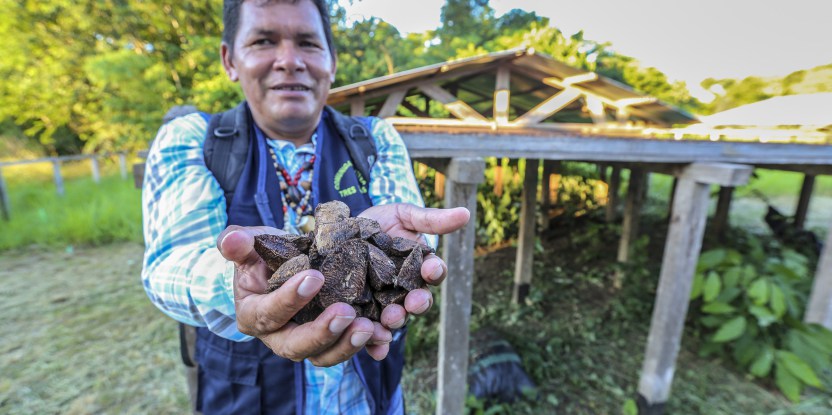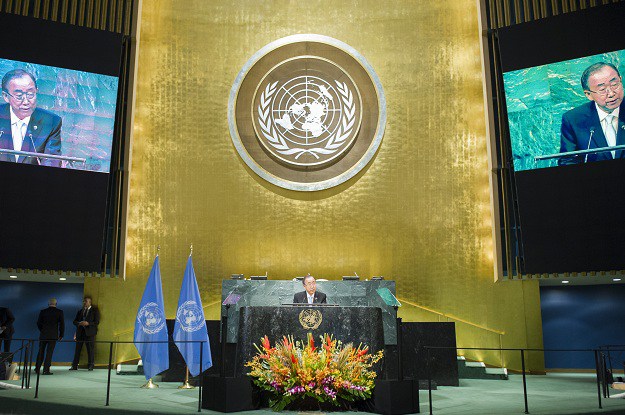
BOGOR, Indonesia — We must continuously adapt our institutions to deal with accelerated social and environmental change if we are to make real progress in protecting forests and achieving sustainability, says Eduardo Brondízio, Professor of Anthropology at Indiana University.
“Our efforts to reconcile development and conservation in forest regions currently rest on unsustainable grounds,” Brondízio said in an interview with Forests News. “We need to confront — intellectually and in practice — several mismatches and misconceptions.”
Brondízio is one of six panelists presenting ‘big ideas’ for discussion at the Colloquium on Forests and Climate: New Thinking for Transformational Change at Columbia University in New York on 24 September, where he hopes to provoke questions that people may not be thinking about — “the kinds of questions that force us to think about the next 10, 20 years.”
He also warned against romanticizing poverty and accepting poor living conditions as “culture” when looking at economic development in forest regions.
An edited transcript of the interview follows.
Q: What is the ‘big idea’ you’ll be discussing at the Colloquium on Forests and Climate?
A: We live in a time of accelerated change. Technology, infrastructure, structural adjustments, population growth, consumption patterns, climate, communication and mobility contribute to increased pressure on the environment and are reconfiguring forest landscapes, particularly in tropical areas.
In this context, it’s amazing how much progress we’ve made in the last 20 years in recognizing the importance of forests, in developing institutions to protect and manage them, and in recognizing the role and value of indigenous and rural peoples. It’s also amazing how recurrent the structural problems are that have limited the effectiveness of these institutions and the development gains so needed in these regions.
But this is the reality of our time, and we require both long-term vision and continuously rethinking and adapting our institutions to the challenges of a changing society and environment. The Amazon, where I have been working for the past 25 years, is a microcosm of these advances and problems, and one that mirrors many other regions of the world.
We’ve come a long way in recognizing the value of ecosystem services and environmental functions as well as the intangible values of nature
So, while we have made a lot of progress, our efforts to reconcile development and conservation in forest regions currently rest on unsustainable grounds. We need to confront — intellectually and in practice — several mismatches and misconceptions.
These are some of the points, developed in collaboration and publications with colleagues, which I want to call attention to.
Q: What are these mismatches you’re talking about?
A: The first is a mismatch of governance institutions.
One of the most visible and successful efforts to decrease the impact of development on biodiversity in the past 20 years has been the implementation of different kinds of protected areas and indigenous reserves. The scale, speed, and impact have been mind-boggling — from insignificant to more than half of the land area in some regions.
Research suggests that for countries such as Brazil, the most significant gains in reducing carbon emissions have come from prevented deforestation in areas protected and managed by local communities.
But as farms and cities expand, these areas are increasingly becoming conservation islands amid areas of change, but systems designed to govern them can only deal in a limited way with the pressures that are emerging all around.
Reserves and parks have been successful so far as a rapid response to the pressure of agribusiness expansion and extractive commodities, but need to be reconsidered if they are to continue to protect forest landscapes.
So we need now new ways of thinking about conservation at a landscape level, to come up with institutions that can bridge different governance systems.
The second is a mismatch of values.
We’ve come a long way in recognizing the value of ecosystem services and environmental functions as well as the intangible values of nature. But we haven’t been able to change the political economy of extractivism, which seeks a fast rate of return at low cost and promotes value aggregation away from the areas where resources are generated.
Compensating people — through payments for environmental services, including REDD+ — has just not been enough to deal with scale of the development needs in forested regions. We need to move beyond economies of subsidies. This requires reconsidering the way we think about resource economies, from the still-dominant extraction and export path to an emphasis on transformation and value aggregation.
If we do not add value to resources locally, we’re not changing the equation of environmental degradation, poverty and the under-development of tropical forest areas around the world.
The third is a mismatch of representation and expectations.
Since the 1980s, we have seen a leap forward in terms of valuing the rights of indigenous and local people who are in charge of conserving forest landscapes in many regions of the world.
But increasingly we see an idealization of indigenous ways as ‘ecologically noble,’ and economically frozen in time. And that is not what you find on the ground.
At the extreme, we run the risk of romanticizing poverty and accepting poor living conditions as ‘culture.’ We cannot ignore the desires and expectations that people have — they too want to improve their lives, and we risk creating conflict based on misrepresentation and mismatches of expectations.
Fortunately, there is also significant mobilization among indigenous and local communities to make their voice heard and their needs addressed.
Q: What do you hope people leave the event thinking about?
A: I hope people take home a positive view about our ability to confront these challenges, but also a recognition that we have to confront deep, recurrent structural problems. In 20 years, it’s impressive the amount of organization, collective action and behavioral changes achieved — recognizing the rights of people, creating democratic institutions, and mechanisms to deal with environmental and social issues. More needs to be done, but we’ve come a long way.
Yet, the process of dealing with climate change and other global changes is a continuous one. Institutions don’t last in themselves. We need to continuously adapt and re-craft them to deal with the changing reality of society in a time of climate change and social acceleration.
Q: Why are events like this important?
A: I hope that we provoke questions that people may not be thinking about.
These are the kinds of questions that force us to think about the next 10, 20 years. We have achieved a lot in forest conservation, land governance, and climate change adaptation — and now we can see the limits of that.
We’ve come a long way in valuing resources and ecosystem services and granting rights to local communities living in productive conservation areas. The evidence now — and people need to hear this — is that it’s not economically sustainable. You have other competing uses that will start to pressure the resource. If we do not think about a new era of decentralized and sustainable industrialization, where we transform resources as locally as possible, we’ll continue to export raw materials from the most resource-rich but socially poor areas of the world, and leave the costs behind.
People do have, with the best intentions possible, romanticized ideas about different social groups and cultures, and what they expect from them. And it’s important that we decouple the idea that local and indigenous values and knowledge are not compatible with expectations about economic improvement and access to goods and services. We should recognize the value of local communities and indigenous groups for what they are — not for how they can serve our romanticized stereotypes.
A forum like this is aimed at being provocative. It’s aimed at raising new questions and perhaps bringing people out of their comfort zone, but into a constructive dialogue so we can confront the intersection of new and old challenges, and to critically consider what they imply.
For more information about the Colloquium on Forests and Climate, click here.
We want you to share Forests News content, which is licensed under Creative Commons Attribution-NonCommercial-ShareAlike 4.0 International (CC BY-NC-SA 4.0). This means you are free to redistribute our material for non-commercial purposes. All we ask is that you give Forests News appropriate credit and link to the original Forests News content, indicate if changes were made, and distribute your contributions under the same Creative Commons license. You must notify Forests News if you repost, reprint or reuse our materials by contacting forestsnews@cifor-icraf.org.


